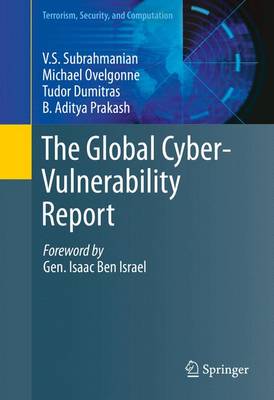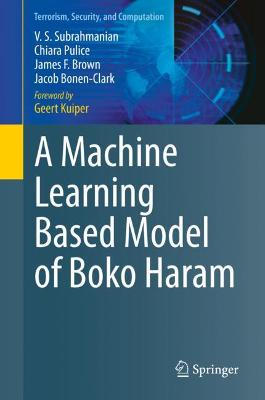Terrorism, Security, and Computation
2 total works
The Global Cyber-Vulnerability Report
by V.S. Subrahmanian, Michael Ovelgonne, Tudor Dumitras, and Aditya Prakash
This is the first book that uses cyber-vulnerability data to explore the vulnerability of over four million machines per year, covering a two-year period as reported by Symantec. Analyzing more than 20 billion telemetry reports comprising malware and binary reputation reports, this book quantifies the cyber-vulnerability of 44 countries for which at least 500 hosts were monitored.
Chapters explain the context for this data and its impact, along with explaining how the cyber-vulnerability is calculated. This book also contains a detailed summary of the cyber-vulnerability of dozens of nations according to the percentage of infected hosts and number of infections. It identifies relationships between piracy rates, GDP and other country indicators. The book contains detailed information about potential cyber-security policies that 44 countries have announced, as well as an analysis of gaps in cyber-security policies in general.
The Global Cyber-Vulnerability Report targets researchers and professionals including government and military workers, policy-makers and law-makers working in cybersecurity or the web intelligence fields. Advanced-level students in computer science will also find this report valuable as a reference.
A Machine Learning Based Model of Boko Haram
by V.S. Subrahmanian, Chiara Pulice, James F Brown, and Jacob Bonen-Clark
This is the first study of Boko Haram that brings advanced data-driven, machine learning models to both learn models capable of predicting a wide range of attacks carried out by Boko Haram, as well as develop data-driven policies to shape Boko Haram's behavior and reduce attacks by them. This book also identifies conditions that predict sexual violence, suicide bombings and attempted bombings, abduction, arson, looting, and targeting of government officials and security installations.
After reducing Boko Haram's history to a spreadsheet containing monthly information about different types of attacks and different circumstances prevailing over a 9 year period, this book introduces Temporal Probabilistic (TP) rules that can be automatically learned from data and are easy to explain to policy makers and security experts. This book additionally reports on over 1 year of forecasts made using the model in order to validate predictive accuracy. It also introduces a policy computation method to rein in Boko Haram's attacks.
Applied machine learning researchers, machine learning experts and predictive modeling experts agree that this book is a valuable learning asset. Counter-terrorism experts, national and international security experts, public policy experts and Africa experts will also agree this book is a valuable learning tool.

